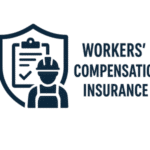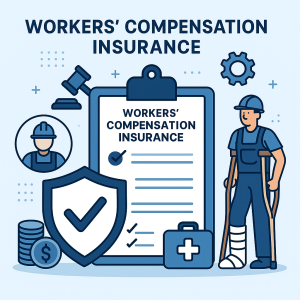
Best Workers’ Comp Providers—GA Job Placement Agencies
August 18, 2025
Shift Handover Safety: Preventing Injuries & Workers Comp Claims
August 18, 2025In today’s dynamic logistics and supply chain environment, warehouse staffing agencies play a critical role in meeting fluctuating labor demands.However, managing the costs associated with workers’ compensation insurance remains a significant challenge for these agencies. Workers’ comp expenses directly impact profitability, operational budgets, and client relationships, necessitating a strategic approach to risk management and claims handling. This article delves into the key factors influencing workers’ compensation costs within warehouse staffing agencies and explores effective strategies to optimize expenses while ensuring compliance and workforce safety.
Table of Contents
- Workers Comp Cost Drivers in Warehouse Staffing Agencies
- Risk Management Strategies to Mitigate Workers Comp Expenses
- Impact of Regulatory Compliance on Workers Comp Premiums
- Best Practices for Negotiating Workers Comp Insurance Rates
- Q&A
- the Conclusion
Workers Comp cost Drivers in Warehouse Staffing Agencies
When evaluating workers’ compensation expenses, warehouse staffing agencies face unique challenges driven primarily by the physical demands and fast-paced nature of warehouse work. High frequency of manual material handling,operating heavy machinery like forklifts,and repetitive motion all contribute to increased injury risks. Additionally, the transient nature of temporary staffing leads to variability in skill levels and training consistency, which can elevate accident rates. Agencies frequently enough encounter a mix of short-term and long-term placements, complicating risk management and claims oversight, thereby affecting insurance premiums.
Several key factors influence claims frequency and severity in this sector, including:
- workforce turnover: High turnover rates can dilute safety culture and reduce adherence to protocols.
- Training adequacy: Inconsistent or rushed onboarding may increase vulnerability to workplace hazards.
- Ergonomic conditions: Poorly designed tasks contribute to musculoskeletal disorders,often resulting in costly claims.
- Shift scheduling: Extended or irregular shifts may exacerbate fatigue-related incidents.
To illustrate the impact, the table below outlines common injury types and their typical effect on workers’ comp costs:
| Injury Type | Cost Impact | Frequency |
|---|---|---|
| Musculoskeletal Disorders | High | common |
| Slip and Fall Injuries | Moderate | Frequent |
| Forklift-related accidents | Very High | Less Frequent |
| Cuts and Lacerations | Low | common |
Risk Management Strategies to Mitigate Workers Comp Expenses
Implementing proactive safety protocols is an essential driver for reducing workers’ comp expenses in warehouse staffing agencies. Regular employee training focusing on equipment handling, hazard identification, and proper lifting techniques can substantially decrease workplace injuries. Additionally, fostering a culture of open dialog encourages staff to report potential risks early, allowing management to address concerns before they escalate. Integrating ergonomic solutions and investing in personal protective equipment (PPE) tailored specifically to warehouse environments reinforces daily safety practices and protects workers from common hazards.
A strategic approach also involves data-driven monitoring and assessment of workplace incidents. Utilizing incident tracking software and conducting thorough post-incident evaluations reveal patterns and underlying causes of injuries. These insights enable agencies to deploy targeted interventions such as redesigning workflows or adjusting staffing levels during high-risk activities. Below is an example of a streamlined risk management checklist that can be adapted to fit specific warehouse operations:
| Risk management checklist | Action Item | Priority |
|---|---|---|
| Equipment Maintenance | Schedule monthly inspections and repairs | High |
| Employee Training | Quarterly safety workshops | Medium |
| Incident Reporting | Implement digital reporting system | High |
| Ergonomics | Install adjustable workstations | Low |
Impact of Regulatory Compliance on Workers Comp Premiums
Adhering to regulatory compliance is a pivotal factor influencing workers’ compensation premiums for warehouse staffing agencies. Agencies prioritizing compliance often demonstrate reduced claims frequency and severity, signaling to insurers a commitment to workplace safety and risk mitigation. This proactive approach can lead to tangible premium discounts, as insurance carriers recognize the lowered probability of costly claims. Conversely, agencies with lax compliance protocols may face escalating premiums due to perceived higher risks and potential penalties.
Key compliance elements impacting premiums include:
- Rigorous employee training programs adhering to OSHA standards
- Thorough injury reporting and documentation processes
- Regular workplace safety audits and corrective action plans
- Effective claims management and follow-up procedures
Investing in these compliance areas not only enhances employee safety but also positions warehouse staffing agencies to negotiate more favorable insurance terms, ultimately contributing to cost control and operational stability.
Best Practices for Negotiating Workers Comp Insurance Rates
When aiming to reduce workers’ comp insurance rates, it’s crucial for warehouse staffing agencies to approach negotiations armed with detailed data and a thorough understanding of risk management. Begin by compiling comprehensive loss history reports that highlight your low incident rates or accomplished claims management-this demonstrates your commitment to safety. Don’t hesitate to emphasize any implemented workplace safety programs and training protocols,as these factors can significantly sway underwriters’ perception of your risk profile. Moreover,be prepared to discuss your agency’s hiring criteria and employee screening processes,which can directly impact claims frequency and severity.
Strategic negotiation is also about exploring alternative pricing options and coverage flexibility. Engage insurers by requesting a breakdown of premium components and inquire about available discounts for bundling policies or leveraging experience modifications. Focus on the following key tactics:
- Leverage industry benchmarks to argue for competitive rates based on your agency’s operational standards.
- Negotiate payment terms to improve cash flow without compromising coverage.
- Request premium audits post-contract to ensure adjustments reflect actual payroll fluctuations.
| Negotiation Strategy | Expected Outcome |
|---|---|
| Highlight Safety Programs | Premium Discounts |
| Request Experience Mod Factor Review | Lower Rate Adjustments |
| Bundle Insurance Policies | Reduced Overall Costs |
| Flexible Payment Plans | Improved Cash Flow |
Q&A
Q&A: Understanding Workers’ Comp Costs for Warehouse Staffing Agencies
Q1: What is workers’ compensation insurance, and why is it significant for warehouse staffing agencies?
A1: workers’ compensation insurance provides coverage for medical expenses, rehabilitation costs, and lost wages if an employee is injured on the job.For warehouse staffing agencies, it is a critical safeguard due to the physical nature of warehouse work, which often involves heavy lifting, machinery operation, and repetitive tasks that increase injury risk. It not only protects workers but also shields agencies from costly lawsuits and helps maintain compliance with labor laws.
Q2: How are workers’ comp costs steadfast for warehouse staffing agencies?
A2: Workers’ comp costs are calculated based on several factors: the agency’s payroll size, the classification of the job roles (with warehouse positions typically in higher-risk categories), the agency’s claims history, and the state-specific workers’ compensation rates. Additionally, safety programs, employee training, and injury prevention measures can influence premium rates by reducing risk.
Q3: What makes warehouse staffing agencies especially vulnerable to higher workers’ comp premiums?
A3: Warehouse staffing agencies often face higher premiums because warehouse jobs generally have higher injury rates compared to office or administrative roles. The transient nature of temporary staffing can also contribute to inconsistent training and familiarity with safety protocols, increasing the likelihood of accidents. Moreover, variability in client site conditions can pose unforeseen hazards.
Q4: What strategies can warehouse staffing agencies employ to manage and reduce workers’ comp costs?
A4: Agencies can implement comprehensive safety training tailored to warehouse duties,conduct regular risk assessments,and foster a culture of safety among placed workers and client sites. Investing in ergonomic equipment and proper protective gear also helps minimize injuries. additionally, partnering with clients who maintain strong safety standards and closely monitoring claims to identify trends enables effective cost control.
Q5: How does claims management impact workers’ compensation costs for warehouse staffing agencies?
A5: Effective claims management reduces costs by ensuring prompt reporting, thorough investigations, and appropriate medical treatment. Timely return-to-work programs can help minimize lost time and productivity losses, which in turn lowers the impact on insurance premiums. Poor claims handling, conversely, can elevate costs thru prolonged claims and increased payout amounts.
Q6: Are there regulatory considerations warehouse staffing agencies should be aware of regarding workers’ compensation?
A6: Yes, staffing agencies must comply with state workers’ compensation laws, which can vary significantly. It is indeed crucial to understand classification rules, reporting requirements, and coverage mandates. Agencies should also be vigilant about contracts with client companies to clarify liability and ensure appropriate coverage for all temporary workers.
Q7: What role do insurance brokers or carriers play in managing workers’ comp costs for warehouse staffing agencies?
A7: Insurance brokers and carriers provide expert guidance on policy selection, risk management solutions, and premium optimization. They can help agencies explore options like experience modifications, large deductible plans, or captive insurance programs tailored to the warehouse staffing industry. Their expertise is valuable in negotiating competitive rates and ensuring comprehensive coverage.
Q8: How can technological advancements help reduce workers’ comp costs in warehouse environments?
A8: Technologies such as wearable safety devices, automated inventory systems, and AI-driven risk analytics can enhance workplace safety by identifying hazards and preventing accidents before they occur. Additionally, digital claims management platforms streamline reporting processes and improve communication between stakeholders, leading to more efficient claims resolution and cost reduction.
This Q&A provides warehouse staffing agencies with actionable insights to better understand and manage their workers’ compensation costs, balancing risk mitigation with operational effectiveness.
The Conclusion
managing workers’ compensation costs is a critical component for warehouse staffing agencies aiming to maintain profitability and operational efficiency.By investing in comprehensive safety training, implementing rigorous risk management protocols, and fostering a culture of workplace safety, agencies can mitigate potential claims and reduce premiums.Staying informed about regulatory changes and partnering closely with insurance providers further enables proactive management of workers’ comp expenses. Ultimately, a strategic approach to controlling these costs not only protects the workforce but also strengthens the agency’s competitive position in the dynamic warehousing sector.
“This content was generated with the assistance of artificial intelligence. While we strive for accuracy, AI-generated content may not always reflect the most current information or professional advice. Users are encouraged to independently verify critical information and, where appropriate, consult with qualified professionals, lawyers, state statutes and regulations & NCCI rules & manuals before making decisions based on this content.







